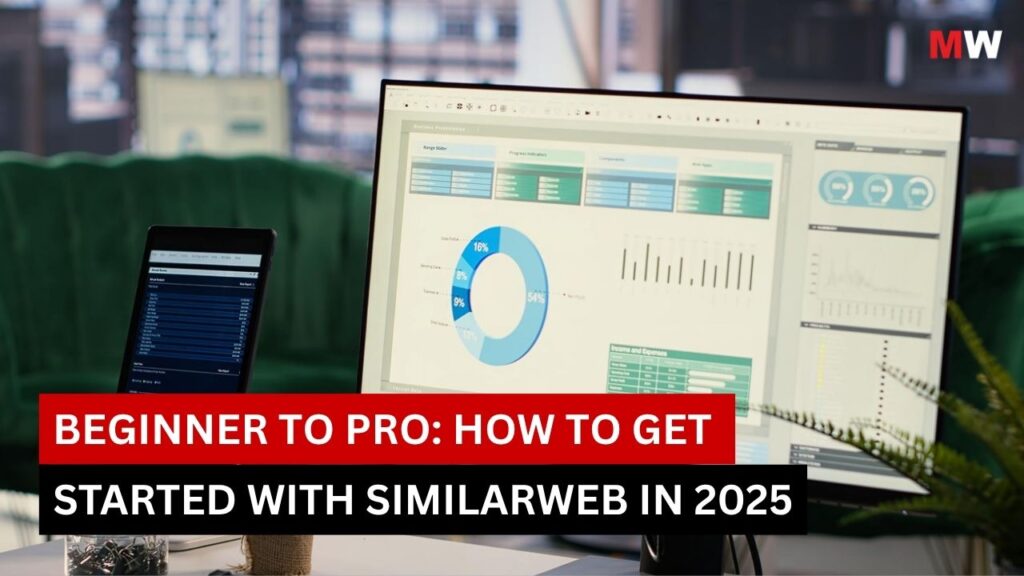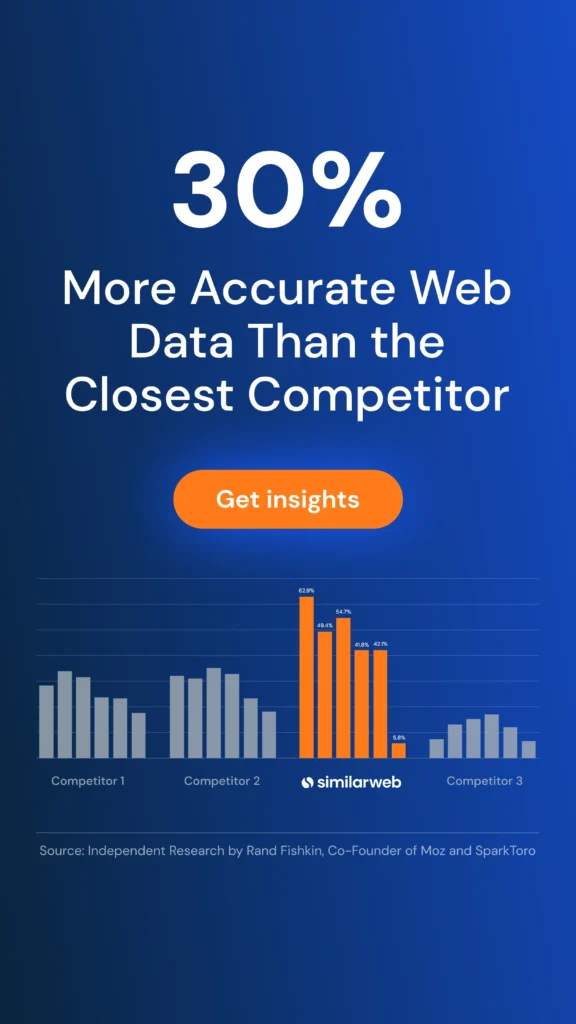Introduction

Let’s be honest. Running a business online feels like a game where the rules change overnight. You build a website. You make slight modifications and even spend on ads. Well, you try to polish every pixel, hoping people will notice. There will be a change. But what do you see? Traffic doesn’t rise. Sales don’t move.
And meanwhile, your competitor? The one who seems to do half the work you have been doing? Well, they are flying ahead. Their campaigns pop up everywhere. Their brand keeps showing in front of your audience. And you’re left asking: what are they doing right that I’m not?
Here’s the hard truth—you’re mostly working on guesses. Sure, you see your own numbers in Google Analytics. But do you really know where their traffic comes from? Which keywords do they rank for? How do they spread their ad spend? No, right? That’s where the gap is; that’s the black hole where your effort disappears.
And it’s not just about competitors. There’s more to it:
- Maybe you don’t fully understand your audience yet.
- Maybe your sales team is hunting leads without knowing which businesses are actually active online.
- Perhaps you’re spending on ads that don’t convert?
- Maybe your content isn’t exactly aligned with what people are searching for.
- Perhaps you’re missing trends that could have made you the “first mover.”
- For you, benchmarking feels impossible, well, because you don’t know if your numbers are good or not.
And so the list goes on and on…all of this adds up to your frustration, wasted time, and wasted budget.
That’s the gap Similarweb was built to close: a way to actually see the bigger picture. A tool that cuts your guesswork out of digital growth. Let’s face it, the growth you see online? That’s not an overnight magic. That’s data, patterns, and choices that you made at the right time. And Similarweb makes those choices clearer for you.
So, let’s dive into the next sections, where we will break down all the key information about Similarweb and how you can progress from guessing to actually starting to become a pro.
Why Digital Intelligence & Web Analytics Matter in 2025
In 2025, being online isn’t special anymore. Everyone is online. And the real question is, how do you stay visible when algorithms flip overnight, new platforms show up out of nowhere, and audiences shift faster than you can keep up?
And talking about attention spans? That’s way shorter now. Say competition? Wide. Global. And one wrong move—one wrong ad, a wrong keyword, or even a wrong channel—can drain your budget in weeks. Guesswork is way too expensive to rely on.
That’s where you need digital intelligence and web analytics to step in. Not just dashboards. Not just numbers. But clarity. The shift from “we think this works” to “we know this works.” Data shows what actually drives clicks, sales, and brand loyalty. It shows why your customers behave the way they do and how your competitors adapt, right away, as it happens.
And here’s the thing—it’s not just some big guys playing this game anymore. Now, you’ll find small businesses, startups, and even solo creators with a laptop and Wi-Fi, all of them leaning on digital intelligence just to keep up, let alone grow.
Because the market in 2025 is only speeding up faster than you can even think of.
That’s why this stuff matters more than ever. It’s not “nice to have” anymore. It’s survival. It’s the edge every brand needs if they want to stay visible, relevant, and maybe even one step ahead. To make things easier, Similarweb has a one-stop solution for all your digital intelligence and web analytics problems. So let’s stick around for the upcoming sections and catch up on what Similarweb really is.

Introducing Similarweb: What Is It, and How Does It Work?
So, imagine driving a car with your windshield covered halfway. You can still move forward and continue driving, for sure, but you’ll end up missing turns, wasting fuel, and might even end up crashing. That’s what working without data feels like.
Now flip it with your scenario. With data, the road is clear. You see where the traffic is. You spot shortcuts. You avoid dead ends. And you get to your destination faster, with fewer costly mistakes. And the platform providing you the data, clearing the road for you—well, yes, that’s Similarweb.
So, what exactly is Similarweb? Think of it like your behind-the-scenes view of the web. It’s not just your own numbers or your dashboard. But the bigger picture—your competitors, your market, your audience—all of it laid out in one place for your ease.
At its core, Similarweb tracks and analyzes web traffic. That’s it, simple. Who’s visiting your website? Where do they come from? Which of your channels actually pulls people in? And what do those people do once they land on your site?
The great thing is it doesn’t stop there. You also get to see keyword performance. Your referral sources, ad campaigns, and even app usage and industry benchmarks. All the stuff that usually hides in ten different tools is now stitched together.
The real work? How all that data connects. It’s not just “Oh, my competitor is growing.” It’s also “here’s why they’re growing.” Maybe it’s SEO, paid ads, that they’re winning on socials, or that they’re acing it with partnerships. Context turns plain data into strategy.
In simple terms, Similarweb gives you X-ray vision for the digital world. You stop guessing. You start knowing. Instead of following trends, you’re the one spotting them first.
How does Similarweb actually work?
Think of it like this. Similarweb collects data from websites, apps, search engines, and social media platforms. Every click, visit, or referral tells you a story. Then it pieces it together into a clear picture you can actually use.
Here’s how it works, in three simple ways:
1. Traffic & Engagement Tracking
See where visitors come from—whether that’s search engines, social media, direct hits, or referrals. Which pages of your website get the most attention? How long do people stick around? What do they click next? All of it tells a story.
2. Competitor & Market Analysis
Similarweb lets you get a sneak peek at your competitors. Which channels do they lean on? What’s actually working in their industry? It’s like looking over their shoulder and seeing how you could do better in the market.
3. Keyword & Campaign Insights
Want to know which keywords are pulling traffic? Which campaigns are paying off? Similarweb breaks it down so you can plan smarter content, SEO, ads, and everything.
In short, it takes scattered data and turns it into a clear roadmap. No more guessing. You see patterns. Spot trends. Make decisions with confidence.
Who Should Use It and Why?
So, who do you think actually needs Similarweb? The short, simple answer: anyone who wants to make smarter digital decisions.
1. Marketers: They see which campaigns actually work, which channels bring in traffic, and what content clicks with your audience. No more guessing. Just results.
2. Small Businesses & Startups: You can benchmark yourself against competitors. Spot trends early. Basically, get a cheat sheet for what’s really happening in your industry.
3. Sales Teams: You should probably stop cold-calling blindly. Try to focus only on leads that are actually active online. Saves time.
4. Analysts & Investors: They track digital growth without drowning in your scattered reports. And what they get is fast, clear insights. Simply actionable.
5. Anyone chasing growth: If you want data over hunches, efficiency over wasted effort, and a real edge over competitors—this one’s for you.

The Ultimate Step: Going from Beginner to Pro
You’ve seen what Similarweb can do. But knowing what it does is only the first step. You’ll get the real value when you start using those features step by step, turning raw data into smart moves. Think of it as leveling up.
Step 1: Start with Traffic Insights—Just open the dashboard and look—where are your people coming from? Search engines, socials, random referrals, maybe even direct bookmarks. Patterns always tell a story. That one page that gets more clicks than the rest? That campaign that quietly pulls in traffic, right? Try to notice it.
Step 2: Analyze Competitors- Now, zoom out. You’re not the only one fighting for clicks. Competitors are already out there, testing, failing, and winning. Now, go ahead and look into the channels that are giving them the edge. Which campaigns keep showing up? Don’t just copy-paste their playbook. Don’t be lazy. Instead, you should dig into the “why.” Why did that ad work? Why does their content land better? That’s where the gold hides.
Step 3: Dig into Keywords & Campaigns- Think of keywords as fuel. Some burn fast, bring in clicks, but fade. Others burn slow and steady; those are the ones that turn into sales. The trick? Knowing which is which. Same with campaigns: is SEO carrying you, or are ads doing the heavy lifting? Look at the numbers. They whisper what to do next. Adjust the dials. Repeat. Again and again.
Step 4: Understand Your Audience- Traffic is numbers. But people… people are the heartbeat. Don’t stop at age or country; well, that’s too shallow. Ask: What content keeps them scrolling at 2 AM? Which platform feels like “home” to them? When you figure that out, strategy stops being guesswork. It turns into speaking their language. Meeting them where they already are. And that’s powerful.
Step 5: Connect the Dots—Here’s where things click. Stop staring at isolated stats. Start blending them. Traffic + competitors + keywords + audience. Suddenly, you’ll see that it’s not just data—it’s a story. Trends before they trend. Opportunities before they’re obvious. It’s like seeing the weather forecast before anyone else packs an umbrella.
Step 6: Experiment & Optimize—The final step? Don’t freeze. Don’t overthink. Pro-level growth isn’t about knowing every answer—it’s about running small tests, watching what sticks, and killing what doesn’t. Some ideas will flop. Others will fly. That’s the game. Each experiment sharpens your system. And the system? It keeps you moving forward.
And the best part? You don’t have to figure it all out alone. For every step, every insight, every decision—you’ve got Similarweb right there to guide you.
To know the basics of how to get started with Similarweb is right here:
Step 1: Access the Platform
Easy start. Head over to Similarweb. Hit log in or sign up if you’re new. Two clicks and you’re in.
Step 2: Enter a Website URL
See that search bar? Type in the website you want to stalk… um, analyze. Press enter. Watch the amazing process begin.
Step 3: Analyze Traffic Data
Now that’s the fun part. Total visits, traffic sources, and audience breakdowns. Who’s coming, from where, and why? Numbers that actually tell the background story.
Step 4: Explore Competitor Insights
Click the “Competitors” tab. That’s where you see who else is in the game. Well, in competition with you. Now compare, contrast, and maybe introspect. Their wins (and failures) can be your free lessons.
Step 5: Dive into Keyword Analysis
Keywords. The lifeline of traffic. Peek at what drives clicks for them. Spot the SEO plays. Borrow the strategies, but bend them into your own shape.
Step 6: Set Up Dashboards
Finally, don’t just analyze once and forget. Create your own dashboard. Pick the numbers that matter to you. Keep them in front and center. That way, every login feels like checking the pulse of your business.
And it’s that simple; that’s it.
Solutions Similarweb Offers
Similarweb is not only a tool; it’s a complete toolbox. So, say you have different teams, different goals, but the same pain: clarity. Marketers want to crack traffic. Sales reps chase leads that aren’t ice cold. Investors hunt for signals before the market wakes up. And all of them need one thing: visibility.
That’s what Similarweb gives. It’s like swapping a foggy windshield for a clear one. Suddenly, you don’t just see the road—you see the turns, the shortcuts, and even the roadblocks before they hit.
The different solutions that Similarweb offers:
1. Web Intelligence
See the bigger picture of the internet. Track websites, traffic flows, channels, and engagement. Spot which sites are rising, which are falling, and why.
2. App Intelligence
Go beyond the web. Understand how apps perform—installs, usage, and retention. See what keeps users hooked and what makes them drop off.
3. Shopper Intelligence
E-commerce is messy. Shopper Intelligence shows how customers search, compare, and buy across platforms. You see the whole journey, not just the checkout page.
4. Sales Intelligence
For sales teams tired of blind pitching. Similarweb shows which companies are active, what they’re searching for, and where the digital signals point. That way, you spend time on the right leads.
5. Stock Intelligence
Investors get a digital crystal ball. Traffic, trends, market signals—all before the quarterly reports drop. Helps you spot growth (or decline) early.
6.Data-as-a-Service
For teams who want raw data at scale. APIs, feeds, exports—plug it straight into your systems, dashboards, or models.
7. Advisory Services
Not everyone has an in-house analyst. Similarweb’s experts help decode the data, shape strategies, and find insights you might miss.
8. Custom Reporting
Every business is unique. Build dashboards and reports that match your goals. Track the numbers that actually matter to you, not just generic metrics.
Common Mistakes to Avoid
Even the best tools can be misused. Similarweb is powerful—but only if you use it smartly. Here are some common difficulties:
- Focusing on One Metric Only
Traffic looks attractive, right? Everyone wants more clicks. But don’t get stuck there. Engagement, conversions, referral sources—they all tell a story. One number alone? Misleading.
- Copying Competitors Blindly
Yeah, check what others are doing. Learn from them. But copying every move? Big mistake. Your audience isn’t theirs. Your strategy shouldn’t be either. Find the why behind their wins.
- Ignoring Audience Insights
Age, country, maybe gender—sure, that’s basic. But the real behavior you will get in cross-platform habits, interests, and content preferences. That’s what makes your campaigns actually hit. Skip it, and you’re just guessing.
- Skipping Benchmarks
“Is my traffic good?” Well, that’s hard to tell if you don’t compare. Industry averages give context. Without them, numbers lie. Seriously.
- Overloading with Data
Similarweb throws a ton of info your way. Don’t choke on it. Focus on what matters for your goal. Too much data = analysis paralysis.
- Not Tracking Over Time
One glance? Almost useless. Trends take weeks or months. Watch, adjust, test, and repeat. That’s how you actually learn.
Follow these tips, and you’ll use Similarweb like a pro, not a rookie. It’s powerful—just don’t cloud it with rookie mistakes.
Conclusion
Navigating the digital world? Yeah, it’s messy. Traffic spikes. Trends shift. Competitors pop up overnight. Algorithms change like the wind. It’s a lot.
But here’s the thing: tools like Similarweb cut through the noise. Suddenly, chaos turns into clarity. You don’t have to guess anymore. Patterns emerge. Opportunities show up. Decisions start to actually make sense.
Marketers, sales teams, startups, and investors all get something out of it. You just need to pay attention. Watch traffic. Study competitors. Dive into keywords. Understand your audience. Test. Adjust. Repeat. That’s where real growth lives.
At the end of the day, it’s not about working harder. It’s about working smarter. Similarweb isn’t just a tool. It’s a compass for the digital world. Use it right, and the road ahead? It’s no longer confusing. It’s actionable. Achievable. And yes—it definitely looks like growth.
Frequently Asked Questions (FAQ)
Q1. What exactly does Similarweb do?
Think of Similarweb like a digital X-ray. You get a peek behind the curtain and see website traffic, audience behavior, how competitors are performing, and what’s trending in your market. All in one place. No guesswork.
Q2. Can small businesses benefit from Similarweb, or is it just for big companies?
Big budgets help, sure. But you don’t need one. Startups, e-commerce shops, and solo creators—they all win here. Track competitors, spot trends, and understand your audience. Data doesn’t care about company size. It’s all about how you use it.
Q3. How accurate is the data on Similarweb?
Surprisingly solid. Similarweb mixes multiple sources, direct measurement, panel data, and public stats into a clear picture. Not perfect, but enough to make smart decisions and spot patterns before everyone else does.
Q4. Do I need to be a tech expert to use Similarweb?
No. Dashboards are intuitive. Navigation is simple. Insights are clear. You don’t need a data science degree. Just curiosity. And a willingness to explore.








